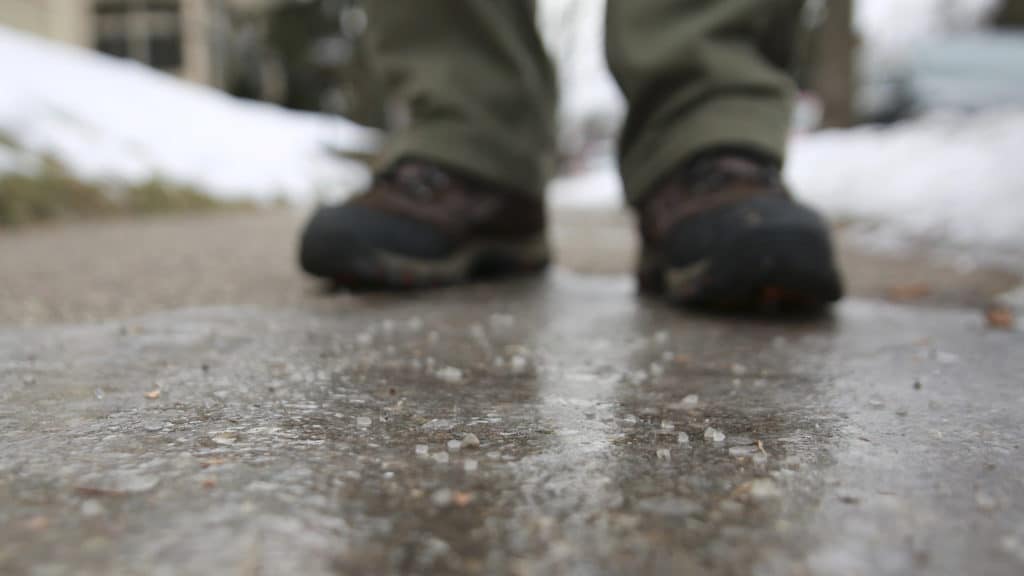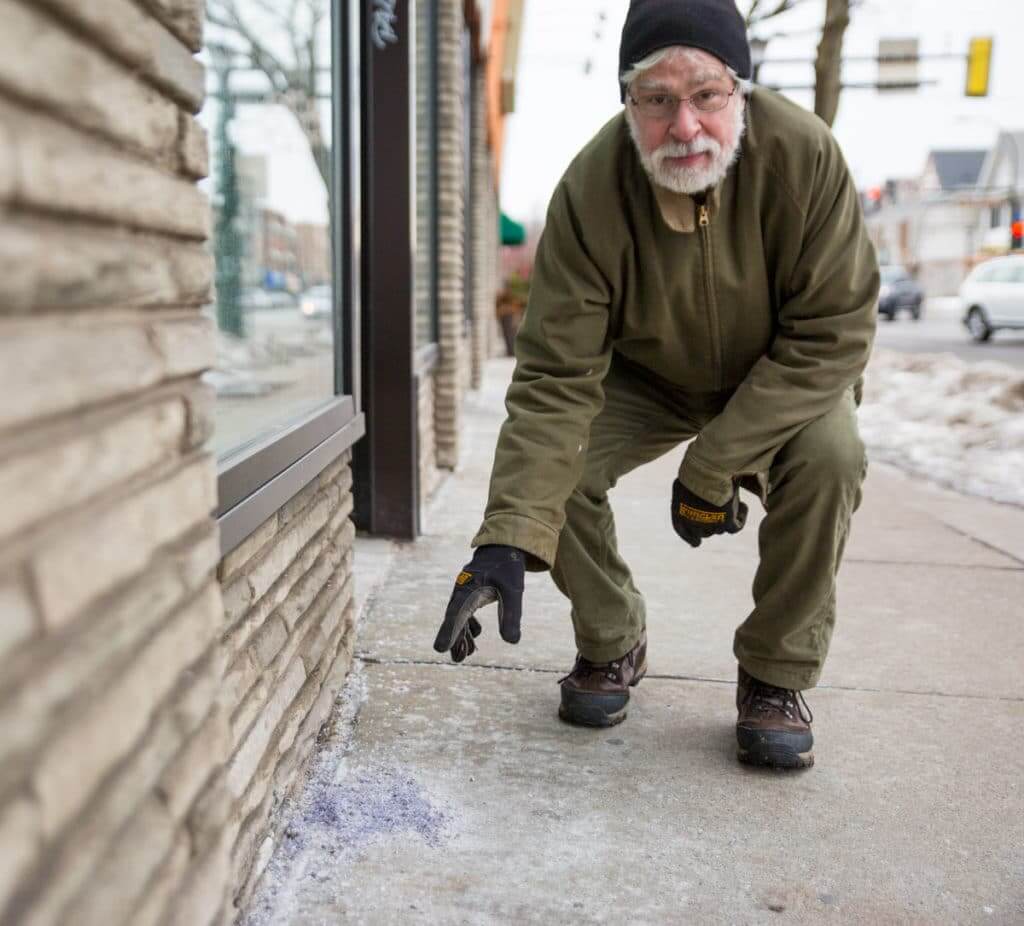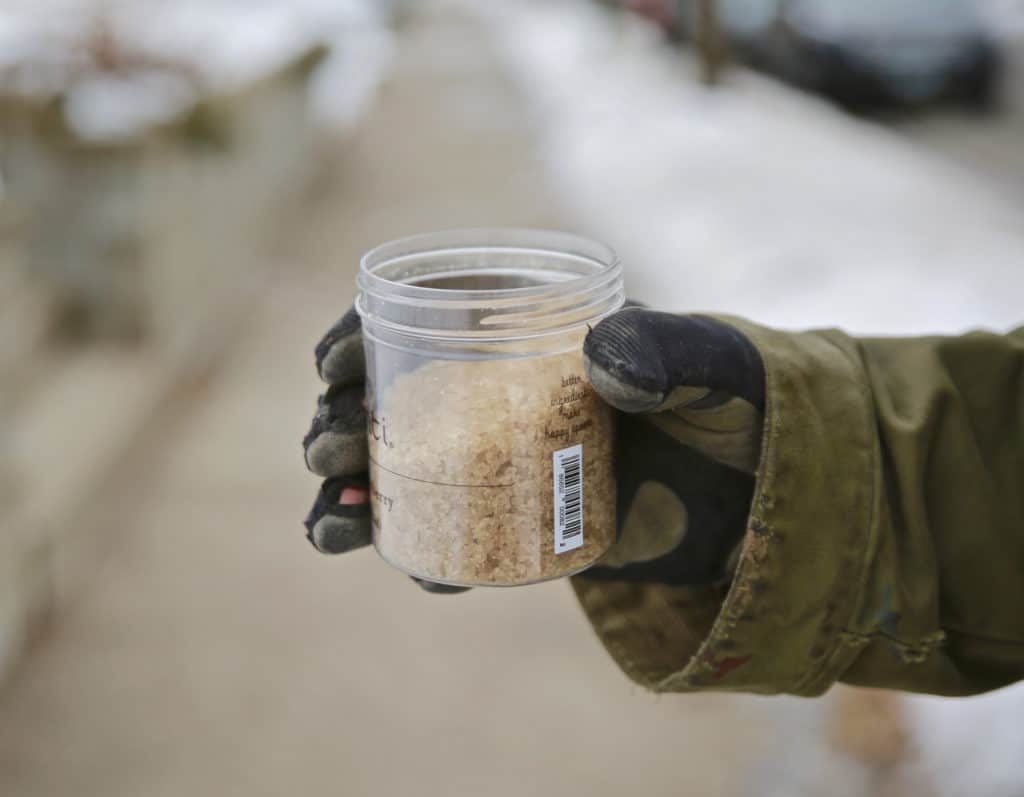Pet Safety
The Iceman Cometh—Sidewalk Salt Pollutes Our Lakes and Streams
- Maddy Wegner
- January 6, 2017
Uptown Wedge resident Joe Knaeble is concerned with a problem that is mostly invisible: increasing levels of salt in groundwater and lakes due to its overuse as a deicer. Less invisible is the sidewalk salt that remains after an over-zealous application of the product to urban sidewalks and roadways.
“If you see salt, it was overdone,” he says.

Most of this problem comes from an American obsession with efficiency. “We are expected to get to work on time, despite the weather,” he notes.
“One of our many environmental problems is that we expect convenience, and don’t even know the price, environmentally.”
(Many Minnesotans think clearing snow and using salt and deicers is the only way to deal with snow on the roads. But compare this to equally challenging Nordic climates, where packing snow instead of clearing streets is the norm, where driving with some of the world’s best snow tires makes such travel manageable, and where snow-packed city streets are navigated with kicksleds.)

Knaeble’s concern with the overuse of salt has led him to sweep more than 270 pounds of excess deicing chemicals from his neighborhood over the past two winters. With the support of neighborhood volunteers, they are trying to prevent metro area bodies of water from becoming as salty as the sea — a problem that is largely irreversible.
To this seemingly thankless task, Knaeble brings a demeanor that reflects his background as a former farmer and carpenter: calm, practical, and informed.
“I wouldn’t say I’m an environmentalist. I’m a person who realizes we have to take care of the environment.”
Minnesota’s Water Problem
While salinity in the watersheds and groundwater may be invisible, its effects are lethal. “It affects aquatic life, inhibiting the ability of deeper lakes, for example, to turn over semi-annually as temperatures change,” says Knaeble. “The toxicity level rises and keeps rising each year.”
Here’s what we know from recent monitoring reports:
- 30% of shallow monitoring wells in the Twin Cities metro already have too much salt;
- 39 metro area lakes and streams are already impaired by too much salt;
- AND an additional 39 lakes and streams will be impaired soon if salting practices don’t change.
“Our snow removal and salting practices need to be reexamined in order to strike a balance between public safety and protecting our groundwater,” says Knaeble, adding that protecting groundwater is also a public safety issue.
Water Stewardship As Catalyst
Knaeble’s awareness of the issue rose when considering a change of career, following his passion for the environment to “Master Water Steward” certification — a volunteer advocacy role that requires 12 sessions on topics ranging from stormwater management to community-based social marketing.

He began noticing salt overuse in his neighborhood, especially where sidewalks meet buildings in retail business areas. So he developed a flyer about putting sidewalks and driveways on a “low-salt diet” and hit the pavement of the commercial corridors in the Wedge neighborhood in Minneapolis. Ultimately, he spoke with 40-50 store employees, learning how they deal with snow and ice.
“I found out that I had a lot to learn about how the system works,” says Knaeble.
Taking Neighborhood Sidewalk Salt Issues to City Hall
While many businesspeople were receptive to the idea of better ways to manage snow and ice, he learned that larger businesses contract with outside companies to handle the issue.
Typically, these outside companies are hired through Special Service Districts (SSD), which provide services beyond those of the municipality via additional taxes.
Knaeble’s efforts caught the attention of businessman friend John Meegan, who owns the Top Shelf men’s shop in the Lyn-Lake neighborhood and serves on the advisory council for the SSD. With his help, they gathered data, and were able to pass a policy within their district that all spills be cleaned up within 24 hours, and that any excess be swept up at the end of the season. Then, through another series of fortuitous connections, they persuaded all 18 Special Service Districts in Minneapolis to follow the same practices.
In the past three years, what is now known as “the Salt Project” has garnered the attention of City Hall, and led to an educational effort by the city’s Public Works to markedly decrease the amount of salt used.
“It’s education, not regulation,” Knaeble emphasizes. Although change is hard to regulate, he hopes businesses will voluntarily embrace best practices.
Best Practices for Using Sidewalk Salt
- Remove snow early, when it’s still easy to shovel. Use a scraper to remove packed snow.
- Shovel often; and, if you can’t shovel, hire someone who can.
- Only use salt on ice, not snow.
- Don’t use sodium chloride when it is colder than 15°F—it won’t work. Magnesium chloride and calcium chloride work at colder temperatures (-10° and -20° respectively).
- 1lb of salt (one heaping coffee mug) is enough to clear a 20-foot driveway or 10 sidewalk squares (250 sq. ft.)
- Sweep up and reuse left-over salt.
- When it is too cold for salt, use sand to create friction instead. You can sweep up and reuse the sand as well.
For more information, see our page on using salt responsibly.

Beyond these practices, Knaeble encourages “change at a basic level.”
“Be an influencer!” he says. “We need to dive into this issue, from above and below.” After all, “The resource at stake is dear to all of us.”
Master Water Stewards, created by the Freshwater Society, is a program that certifies and supports community leaders to install pollution prevention projects that educate community members, reduce pollutants from stormwater runoff, and allow more water to soak into the ground before running into storm sewer systems. https://masterwaterstewards.org/
Want exclusive access to our content?
Join hundreds of subscribers today by signing up for our mailing list. You'll receive exclusive tips, guides, news and much more! Sign up now and learn how to keep your water clean!
Comments are closed.

Aw, this was an exceptionally nice post.
Taking a few minutes and actual effort to generate a superb article… but what can I say… I hesitate a lot and never seem to get
anything done.
Great spot-light on this issue. I am impressed with the policy change and forward thinking Lyn Lake!!
This is awesome. I do the same thing in Highland Park.
Hi Min, I hear you loud and clear. Another Water Steward ran into a similar problem at a Lifetime Fitness. She is struggling to navagate a way to affect change through education.
A few suggestions that will illustrate how complicated affecting change can be. The owners of the mall most likely hire a contractor to remove snow and ice. One strategy is to follow the chain of command at the mall and get to the person who makes the decisions. If they will listen to you they have the power to contact the contractor and have them come back to clean up spillis. Ideally it should be written into all snow and ice removal contracts that the contractors need to use Best Practices, which would include cleaning up spills quickly! Ideally and hopefully eventually, all snow and ice removal contractors should be required to take the MPCA classes and get certified for snow and ice removal.
Another strategy is to contact the city of Albertville and see if they can help exert any influence. They might not even consider deicing salt a pollutant. I can’t find a Watershed District for Albertville although the Mall would flow into the Crow and then the Mississippi. Or it might flow directly into the Mississippi. There should be someone at City Hall who can tell you if Albertville and the Mall are in an organized Watershed District. If the Mall is in an organized Watershed District it should be informed and should be ally.
As you can see tt is going to take a tremendous amount of volunteer time, energy and persistence to educate and affect change. The alternatives are pretty bleak, though. Best of luck!
A new category: The Very Best Practices for snow and ice removal. Don’t use any salt!
Someone should let the Albertville outlet mall in on this info. It’s shameful how big the salt piles are there!!
Way to go, Joe!